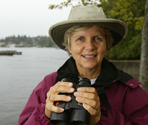

Join BirdNote tomorrow, November 30th!
Illustrator David Sibley and actor H. Jon Benjamin will face off in the bird illustration battle of the century during BirdNote's Year-end Celebration and Auction!
The Spotted Towhee forages mostly on the ground, and even builds its nest on the ground, or close to it. Its mewing call can be heard from the underbrush, as it scuffles in the leaf litter for food. Look for the ruby-red eye that sparkles from its black head. Learn more about the Spotted Towhee at Cornell's All About Birds.
We'd like to know what you think of BirdNote - drop us a line and let us know what you think. Begin here.
BirdNote®
Spotted Towhee
Adapted from a script written by Frances Wood
This is BirdNote!
[“Mew” of Spotted Towhee]
Don’t worry, BirdNote hasn’t “gone to the cats.” This feline-sounding call comes from a common resident bird, the Spotted Towhee.
[“Mew” of Spotted Towhee]
Sometimes called “not-a-robin”, the towhee can look like a robin at first glance, with a dark back and brick-red sides. Take a better look, and you’ll see a white belly and a black hood that covers the head and shoulders. White spots adorn the wings and tail. And those ruby-red eyes that sparkle from its black head!
If that isn’t enough to keep the Spotted Towhee separate from the robin, then watch the way it feeds. A robin searches a lawn looking for worms, but a towhee prefers to forage on dirt under protective vegetation. The towhee hops forward on two legs, inspecting dead leaves for insects. And then—and this is the amazing part—it does a sort of backward bunny-hop to rake the leaf litter behind it and expose tasty morsels.
So, the next time you see a red-eyed, backward-bunny-hopping bird that’s calling like a cat, remember: it’s not a robin. It’s a Spotted Towhee.
[“Mew” of Spotted Towhee]
Scratch up a few more facts about this bird and about BirdNote, and give us a few facts of your own, by taking a quick survey at our web site, BirdNote.org. Thank you.
###
Call of Spotted Towhee and feeding sounds provided by: The Macaulay Library of Natural Sounds at the Cornell Lab of Ornithology, Ithaca, New York.
Sound recordist: K. Colver
Producer: John Kessler
Executive Producer: Chris Peterson
© 2009 Tune In to Nature.org Rev. for March 2009
ID # 032505SPTOKPLU SPTO-01-MM-2009-03-21-









